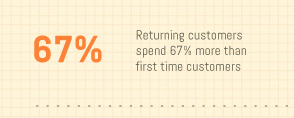
Today's guest post is from Angelica Valentine, Content Marketing Manager at Wiser. You can follow her on Twitter here: @AngelicaSaidSo.
Every retailer knows there are plenty of opportunities to maintain and even grow their sales after the holiday rush. January is a prime time to strengthen customer relationships and extend the life of those initial purchases or even inquiries that happened in late November and throughout December.
How? We've compiled a few helpful tips and tricks in a handy little infographic that we think will help you hit and even exceed your new year's sales resolutions.
Before we explore that graphic in detail, here are a few quick revenue boosting tactics to consider:
Reward Loyalty: Wouldn’t it be nice if all of your customers would keep coming back? Of course! The fact that returning customers spend 67% more than first timers should be a big incentive to put in the hard work required to make this a reality. One suggestion I have is that you email a coupon after all initial purchases as a thank you. It's a good idea to have the offer become valid 2-4 weeks after you send it and last a few weeks at most to create a sense of urgency.
This has been an effective strategy for Sunglass Hut, which cites it as a great way to drive sales during low traffic periods. One of their SEO specialists, Geoff Beers, cites this tactic as a great way to get shoppers back into the store during typically low traffic periods. Plan accordingly and give coupons the potential to make up for historical slumps. Maybe even throw in a reminder email a week before the discount expires to remind shoppers to hop on your site and make an additional purchase.

Be Dynamic: In case you're not familiar with it, dynamic pricing is a pricing strategy that allows businesses to react to changes in the market (like competitor price changes) and internal factors (like stock level) by changing prices to remain competitive and profitable and still meet customer expectations. Amazon is one of the most common examples of a dynamic pricing success story because they reprice about 2.5 million times a day. They use a loss leader strategy to have the lowest price the majority of the time. This is only possible when they are able to react to competitor price changes essentially in real-time.
There are four main steps in implementing a dynamic pricing strategy. First, retailers must collect accurate and timely competitor data. Second, they must decide the minimum and maximum prices they are willing to accept for the product. Third, they can either manually or automatically change prices to keep up with the competition, capitalize on high demand for a unique product, or protect dwindling stock. Fourth, consistent analysis is the key to making sure that you are achieving the results you seek because price optimization is an ongoing process. Many retailers have started to use repricing software to get the most out of each sale and keep up in such a fast-paced market.
Nicholas Schneider, President of HealthDesigns, has been successful with dynamic pricing. He explains, “we thought we knew who our main competitors were, and so we tried to look at the store level at who we had to be cognizant of to earn an order from a value perspective...We have stopped looking at the store level competition solely and are now monitoring areas like brand or product competitiveness to take action on.”

Chat More: Live chat helps you tailor the conversation to what your customers are looking at. Vince La Rosa of Tungsten World tells us, "During the holidays, I could often see that customers were asking questions while in the checkout process. The ability to answer their questions without making them leave that page was vital. Our conversion numbers for customers that chatted with us before placing an order were very high." Remember that most people are instinctually trained to say, “I’m just browsing” in response to the question “Hi, how can I help you today?” Instead, try opening with a specific question that starts the customer down the sales decision path. If they're browsing a post-holiday sales page for bikes, try asking, "Where will you be riding this year?"
Our 'Post Holiday Sales' infographic below has more ideas, or you can tweet your suggestions to @WisePricer and @Olark!
Thanks and good luck to you and your business in 2015! 

